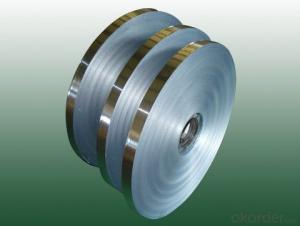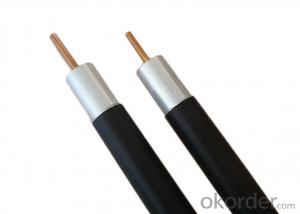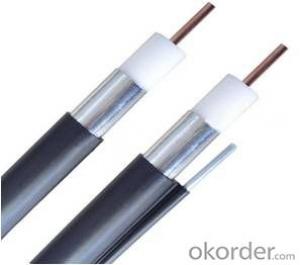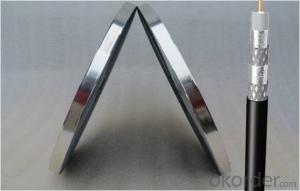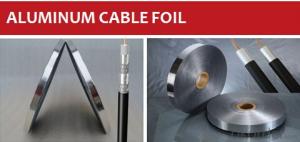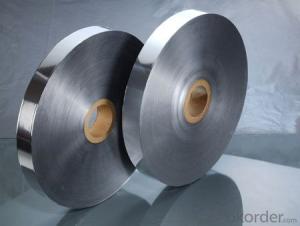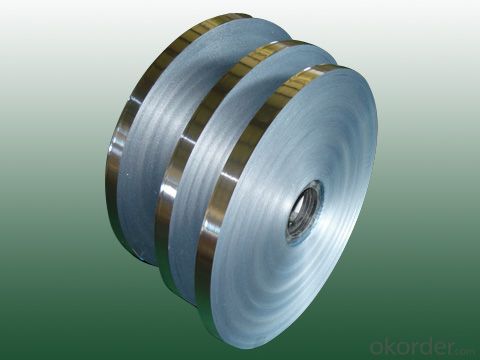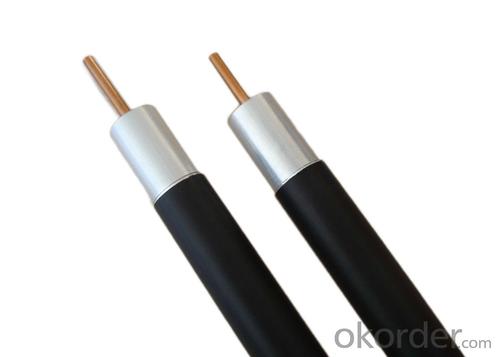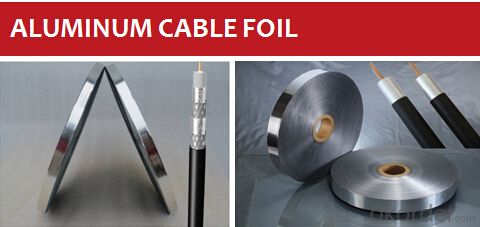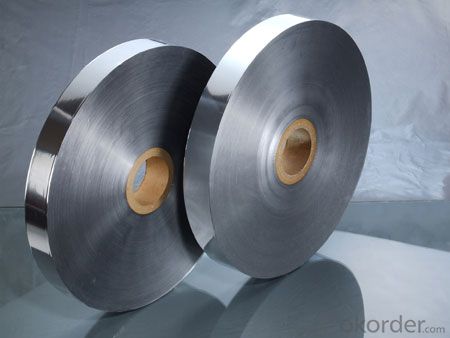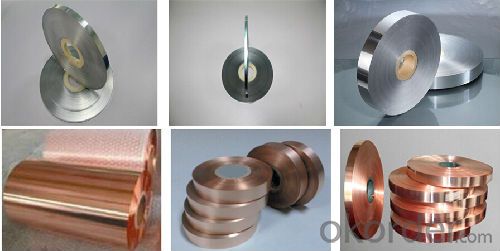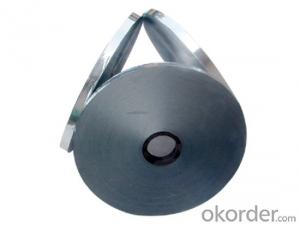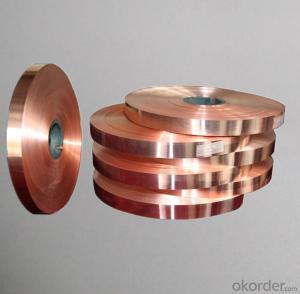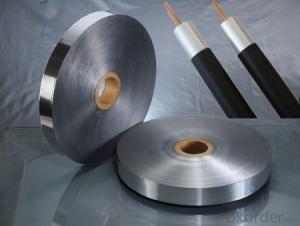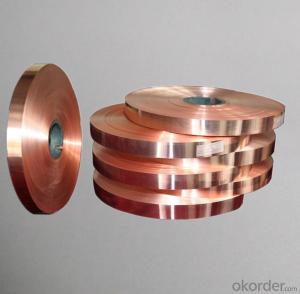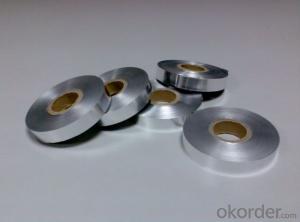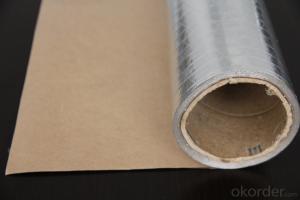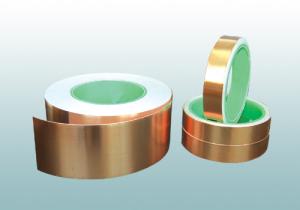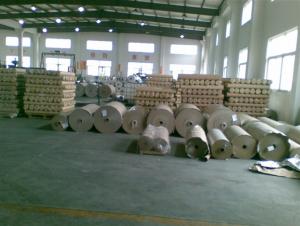Aluminum Foil Facing AL-PET Laminated Foil Composite for Shielding Coaxial Cable
- Loading Port:
- Shanghai
- Payment Terms:
- TT or LC
- Min Order Qty:
- 1000 m²
- Supply Capability:
- 1000000 m²/month
OKorder Service Pledge
OKorder Financial Service
You Might Also Like
Aluminum Mylar foil Shielding Foil for Coaxial Cable communication cable
1.Structure of Aluminum Mylar foil Shielding Foil Description:
Electrical cable is used to transfer electricity, information and the realization of electromagnetic energy transformation. The electrical cable in a broad term mainly indicates to cable and in a narrow term indicate insulation material. Its definition is the aggregation of different parts below: one or more insulation cores, the wrapping layers of the cores, the general protective layers and the outer protective layers. Cables also include additive conductor without insulator.
2.Main Features of the Aluminum Mylar foil Shielding Foil:
Aluminum Mylar foil Shielding Foil is applicable to the shielding of coaxial cable, local network wire, electronic communication cable and computer peripheral wire etc.
1.Thickness: min 6.5mic; width: 300-1000mm.
2. According to GB/T 3198-2010.
3.Usages: cable shield, candy wrap
3. Aluminum Mylar foil Shielding Foil Images
4. Aluminum Mylar foil Shielding Foil Specification
AL-PET laminated foil
Description: Apply for overall or individual twisted pair shield for electronic cable and local network cables, protect from external electromagnetic interference. Features option of LUBRITAPE apply to decrease 50% friction of aluminum surface.
Construction: Aluminum foil, Polyester film
CODE | TOTAL THICKNESS | ALU THICKNESS | GLUE | POLYESTER FILM | WEIGHT |
FP007012 | 22±3 | 7 | 3 | 12 | 38.8±5% |
FP010012 | 25±3 | 10 | 3 | 12 | 46.9±5% |
FP020020 | 43±3 | 20 | 3 | 20 | 83.8±5% |
FP025012 | 40±3 | 25 | 3 | 12 | 87.6±5% |
Special specifications are also available, according to customer’s order. | |||||
AL-PET-AL laminated foil
Description: resilient shielding in cable assembling and provide the enhanced shielding required in harsh environments.
Construction: Aluminum foil +Polyester film+ Aluminum foil
CODE | TOTAL THICKNESS | ALU THICKNESS | GLUE | POLYESTER FILM | GLUE | ALU THICKNESS | WEIGHT |
DFP007015 | 35±3 | 7 | 3 | 15 | 3 | 7 | 65±5% |
DFP009020 | 39±4 | 9 | 3 | 15 | 3 | 9 | 76±5% |
DFP015025 | 61±5 | 15 | 3 | 25 | 3 | 15 | 115±5% |
DFP025025 | 80±5 | 25 | 3 | 25 | 3 | 25 | 175±5% |
Special specifications are also available, according to customer’s order. | |||||||
Bonded AL-PET laminated foil
Description: A laminated aluminum-polyester-aluminum tape is fully bonded to the foam dielectric to provide 100% coverage, longitudinally applied over the polyethylene core and the tape minimizes signal leakage.
Construction: Aluminum foil + Polyester film + Aluminum foil + EMAA film
CODE | TOTAL THICKNESS | ALU THICKNESS | GLUE | POLYESTER FILM | GLUE | ALU THICKNESS | GLUE | EMAA | WEIGHT |
DFPH009012 | 65±5 | 9 | 3 | 12 | 3 | 9 | 3 | 25 | 98±5% |
DFPH009020 | 72±5 | 9 | 3 | 20 | 3 | 9 | 3 | 25 | 108±5% |
DFPH009025 | 75±5 | 9 | 3 | 25 | 3 | 9 | 3 | 25 | 114±5% |
DFPH010025 | 84±5 | 10 | 3 | 25 | 3 | 10 | 3 | 25 | 126±5% |
Special specifications are also available, according to customer’s order. | |||||||||
Copper polyester foil
Description: Copper foil, copper lamination foil typically use as shielding for low/medium voltage cable and radio frequency coaxial cable. The rolled annealing copper foil is flexible to wrap cable core, also it has the excellent physical properties, Polyester film provides electrical insulation and high mechanical properties.
Construction: Copper foil + Polyester film
CODE | TOTAL THICKNESS | CU THICKNESS | GLUE | POLYESTER FILM | WEIGHT |
CP018012 | 33±3 | 18 | 3 | 12 | 175±10% |
CP007020 | 46±3 | 18 | 3 | 25 | 195±10% |
CP015012 | 30±3 | 15 | 3 | 12 | 160±10% |
Special specifications are also available, according to customer’s order. | |||||
5.FAQ
We have organized several common questions for our clients,may help you sincerely:
① Where you used this foil?
Aluminum Mylar foil Shielding Foil is used for cable shield, candy wrap for the shielding of coaxial cable, local network wire, electronic communication cable and computer peripheral wire etc.
②How to guarantee the quality of the products?
We have established the international advanced quality management system,every link from raw material to final product we have strict quality test;We resolutely put an end to unqualified products flowing into the market. At the same time, we will provide necessary follow-up service assurance.
③How long can we receive the product after purchase?
In the purchase of product within three working days, We will arrange the factory delivery as soon as possible. The pecific time of receiving is related to the state and position of customers.Commonly 7 to 10 working days can be served.
- Q: This question asks for the optimal method of storing aluminum foil to maintain its usability and prevent damage.
- <p>The best way to store aluminum foil is to keep it in a cool, dry place, away from direct sunlight and heat sources. It's advisable to store it in its original box or a resealable plastic container to prevent it from getting crumpled or damaged. Some people prefer to store it with the shiny side facing out for easier identification, while others prefer the dull side out to reduce glare. It's important to ensure that the foil is tightly rolled to prevent it from unraveling or getting tangled.</p>
- Q: Is it possible to use aluminum foil with a reflective side for food freezing purposes?
- <p>Yes, aluminum foil facing can be used for freezing food. It helps to maintain the temperature and prevent freezer burn by acting as a barrier to air and moisture. However, it's important to ensure that the foil is food-grade and does not have any sharp edges that could puncture the food packaging. Additionally, it's recommended to wrap the food securely in the foil to minimize air exposure and maximize the preservation of the food's quality and taste.</p>
- Q: Is it safe and effective to use aluminum foil as a facing material for making soup?
- <p>Using aluminum foil directly to make soup is not recommended. Aluminum foil is not designed for cooking food as it can react with acidic or alkaline ingredients, potentially releasing harmful substances into the food. It is also not heat resistant and can melt or warp when exposed to high temperatures. For safe and effective soup making, use materials specifically designed for cooking, such as stainless steel, enameled cast iron, or non-stick pots. These materials are safe for cooking and can withstand high temperatures without compromising the quality or safety of your soup.</p>
- Q: What are the most effective ways to clean surfaces that have aluminum foil applied to them?
- <p>The best cleaning methods for aluminum foil facing involve gentle cleaning to avoid damaging the foil. Use a soft cloth or sponge with warm water and mild dish soap to wipe the surface. Avoid abrasive cleaners or scrubbing, as this can scratch or tear the foil. For stubborn stains, a mixture of baking soda and water can be applied as a paste and gently rubbed with a soft cloth. Always rinse thoroughly and dry the surface to prevent water spots and maintain the integrity of the aluminum foil.</p>
- Q: What are the methods to stop the aluminum foil from curling at the edges while cooking?
- <p>To prevent the edges of aluminum foil from curling up during cooking, you can dampen the edges with a little water or cooking oil. This helps to weigh down the foil and keep it flat. Additionally, you can fold the edges inward to create a small rim, which can help contain the food and prevent the foil from lifting. Another method is to use a heavier object, such as a ceramic dish or a small pan, to press down on the foil, keeping it in place. Ensure that the object is heat-resistant and won't react with the foil. These techniques can help maintain the integrity of your foil and keep it from curling up during the cooking process.</p>
- Q: This question asks whether glass or ceramic containers are preferable for storing food over plastic or metal containers.
- <p>Glass and ceramic containers are often considered better for storing food due to their non-porous nature, which prevents the absorption of flavors and potential leaching of chemicals. Glass is generally safe for storing both acidic and alkaline foods, while ceramic containers should be checked for lead-based glazes, especially for acidic foods. Plastic containers can leach chemicals over time, and metal containers may react with certain foods, affecting taste or safety. However, the choice also depends on factors like the type of food, storage duration, and personal preference.</p>
- Q: What are the potential health hazards linked to cooking with aluminum foil?
- <p>Cooking with aluminum foil is generally considered safe, but there are some potential health risks. Aluminum can leach into food, especially when it comes into contact with acidic or salty foods at high temperatures. This could lead to increased aluminum intake, which has been linked to neurological disorders like Alzheimer's disease, although more research is needed to establish a definitive link. Additionally, aluminum foil can cause burns or injuries if not handled properly. It's important to use foil responsibly, avoiding direct contact with food when possible, and to follow proper food safety guidelines.</p>
- Q: Is it safe or practical to use aluminum foil as a facing material for cooking purposes?
- <p>Yes, aluminum foil facing can be used for cooking, but with caution. It's often used to line baking sheets, cover dishes for steaming, or wrap foods for roasting. However, it's not recommended for direct contact with acidic or salty foods as it can react and leach aluminum into the food. Also, avoid using it at high temperatures as it can melt and release harmful fumes. Always follow the manufacturer's guidelines for safe use.</p>
- Q: Is it safe and effective to use aluminum foil with a reflective side to wrap vegetables for grilling or roasting?
- <p>Yes, you can use aluminum foil facing to wrap vegetables before grilling or roasting. Aluminum foil is a common and versatile tool in cooking, especially for grilling and roasting. The reflective side of the foil can help in evenly distributing heat and retaining moisture, which is beneficial for cooking vegetables. It prevents them from drying out and allows them to cook evenly. However, ensure the foil does not come into direct contact with the heat source as it may cause the foil to tear or the vegetables to burn. Always monitor the cooking process to prevent any potential issues.</p>
- Q: This question asks about the distinction between aluminum foil made from new raw materials and that made from recycled materials.
- <p>Yes, there is a difference between 'virgin' and 'recycled' aluminum foil. Virgin aluminum foil is produced from newly mined bauxite ore and is considered to be of higher purity. It is often preferred for applications requiring high quality and consistency. Recycled aluminum foil, on the other hand, is made from aluminum waste that has been collected, sorted, and reprocessed. It is more environmentally friendly as it reduces waste and energy consumption. However, recycled aluminum foil may have slight variations in thickness and quality due to the recycling process.</p>
Send your message to us
Aluminum Foil Facing AL-PET Laminated Foil Composite for Shielding Coaxial Cable
- Loading Port:
- Shanghai
- Payment Terms:
- TT or LC
- Min Order Qty:
- 1000 m²
- Supply Capability:
- 1000000 m²/month
OKorder Service Pledge
OKorder Financial Service
Similar products
Hot products
Hot Searches
Related keywords
